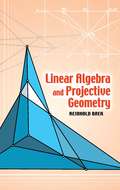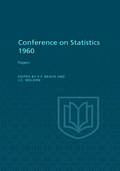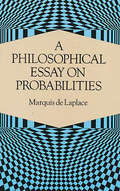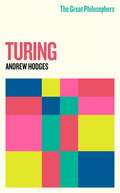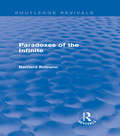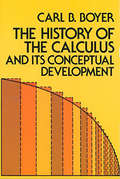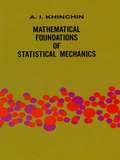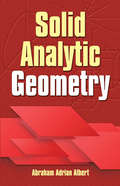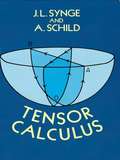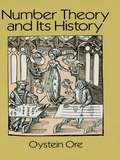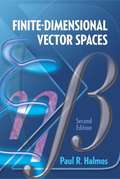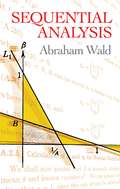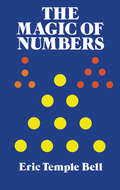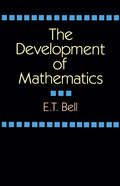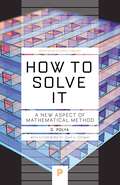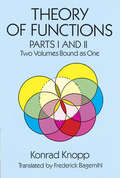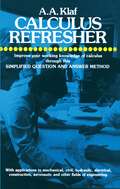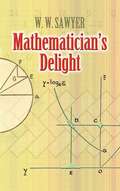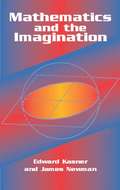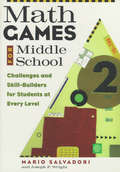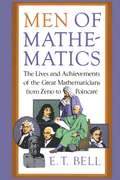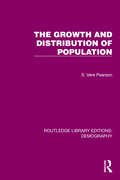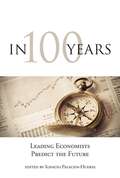- Table View
- List View
Linear Algebra and Projective Geometry
by Reinhold BaerGeared toward upper-level undergraduates and graduate students, this text establishes that projective geometry and linear algebra are essentially identical. The supporting evidence consists of theorems offering an algebraic demonstration of certain geometric concepts. These focus on the representation of projective geometries by linear manifolds, of projectivities by semilinear transformations, of collineations by linear transformations, and of dualities by semilinear forms. These theorems lead to a reconstruction of the geometry that constituted the discussion's starting point, within algebraic structures such as the endomorphism ring of the underlying manifold or the full linear group.Restricted to topics of an algebraic nature, the text shows how far purely algebraic methods may extend. It assumes only a familiarity with the basic concepts and terms of algebra. The methods of transfinite set theory frequently recur, and for readers unfamiliar with this theory, the concepts and principles appear in a special appendix.
Conference on Statistics 1960
by J. C. Weldon E. F. BeachIn 1958 the Canadian Political Science Association established a committee to look into ways and means of improving statistical research in the social sciences in Canada. One of the ways in which the committee thought this could be done was by establishing an annual forum where papers could be presented and discussed. Eight papers given at the first Conference at Queen's University are contained in this volume. Diverse alike in subject and statistical method---as indeed a collection of papers reflecting the purpose of the founding committee is bound to be---the papers as printed incorporate the discussion that attended their presentation in 1960.The papers are: K.A.H. Buckley, "Historical Estimates of Internal Migration in Canada,"; Richard E. Du Wurs, Robert Batson, Margaret Daffron, "The 'Mass Society' and 'Community' Analyses of the Social Present"; P.J. Giffen, "Canadian Criminal Statistics"; E.J. Hanson, "The Post-war Rise of the Crude Petroleum Industry"; Gideon Rosenbluth, "Salaries of Engineers and Scientists, 1951"; David N. Solomon, Agnes M. Fergusson, "The Distribution and Functions of Canadian Engineers and Scientists"; K.W. Studnicki-Gizbert, "The Structure and Growth of the Canadian Air Transport Industry"; T.R. Vout, "The Canadian Manufacturing Industry, 1900-57."
A Philosophical Essay on Probabilities
by Marquis De LaplaceThis classic introduces the concepts and uses of probability theory. It demonstrates, without the use of higher mathematics, the application of probability to games of chance, physics, reliability of witnesses, astronomy, insurance, democratic government, and many other areas. It also shows how scientists can express complex ideas in simple terms.
The Great Philosophers: Turing (GREAT PHILOSOPHERS)
by Andrew HodgesAlan Turing's 1936 paper On Computable Numbers, introducing the Turing machine, was a landmark of twentieth-century thought. It settled a deep problem in the foundations of mathematics, and provided the principle of the post-war electronic computer. It also supplied a new approach to the philosophy of the mind.Influenced by his crucial codebreaking work in the Second World War, and by practical pioneering of the first electronic computers, Turing argued that all the operations of the mind could be performed by computers. His thesis, made famous by the wit and drama of the Turing Test, is the cornerstone of modern Artificial Intelligence.Here Andrew Hodges gives a fresh and critical analysis of Turing's developing thought, relating it to his extraordinary life, and also to the more recent ideas of Roger Penrose.
Paradoxes of the Infinite (Routledge Revivals)
by Bernard BolzanoParadoxes of the Infinite presents one of the most insightful, yet strangely unacknowledged, mathematical treatises of the 19th century: Dr Bernard Bolzano’s Paradoxien. This volume contains an adept translation of the work itself by Donald A. Steele S.J., and in addition an historical introduction, which includes a brief biography as well as an evaluation of Bolzano the mathematician, logician and physicist.
The History of the Calculus and Its Conceptual Development
by Carl B. BoyerThis book, for the first time, provides laymen and mathematicians alike with a detailed picture of the historical development of one of the most momentous achievements of the human intellect - the calculus. It describes with accuracy and perspective the long development of both the integral and the differential calculus from their early beginnings in antiquity to their final emancipation in the 19th century from both physical and metaphysical ideas alike and their final elaboration as mathematical abstractions, as we know them today, defined in terms of formal logic by means of the idea of a limit of an infinite sequence.But while the importance of the calculus and mathematical analysis - the core of modern mathematics - cannot be overemphasized, the value of this first comprehensive critical history of the calculus goes far beyond the subject matter. This book will fully counteract the impression of laymen, and of many mathematicians, that the great achievements of mathematics were formulated from the beginning in final form. It will give readers a sense of mathematics not as a technique, but as a habit of mind, and serve to bridge the gap between the sciences and the humanities. It will also make abundantly clear the modern understanding of mathematics by showing in detail how the concepts of the calculus gradually changed from the Greek view of the reality and immanence of mathematics to the revised concept of mathematical rigor developed by the great 19th century mathematicians, which held that any premises were valid so long as they were consistent with one another. It will make clear the ideas contributed by Zeno, Plato, Pythagoras, Eudoxus, the Arabic and Scholastic mathematicians, Newton, Leibnitz, Taylor, Descartes, Euler, Lagrange, Cantor, Weierstrass, and many others in the long passage from the Greek "method of exhaustion" and Zeno's paradoxes to the modern concept of the limit independent of sense experience; and illuminate not only the methods of mathematical discovery, but the foundations of mathematical thought as well.
Mathematical Foundations of Statistical Mechanics (Dover Books on Mathematics)
by A. Ya. KhinchinPhase space, ergodic problems, central limit theorem, dispersion and distribution of sum functions. Chapters include Geometry and Kinematics of the Phase Space; Reduction to the Problem of the Theory of Probability; and more.
Solid Analytic Geometry (Dover Books on Mathematics)
by Abraham Adrian AlbertThe first seven chapters of this concise text provide an exposition of the basic topics of solid analytic geometry and comprise the material for a one-semester course on the subject for undergraduate mathematics majors. The remaining two chapters offer additional material for longer courses or supplementary study. Chapters 1 and 2 contain a treatment of the equations of lines and planes. Subsequent chapters offer an exposition of classical elementary surface and curve theory, a treatment of spheres, and an examination of the classical descriptions of quadric surfaces in standard position. An exploration of the theory of matrices follows, with applications to the three-dimensional case of quadric surfaces. The text concludes with a survey of spherical coordinates and elements of projective geometry.
Tensor Calculus
by J. L. Synge A. Schild"This book is an excellent classroom text, since it is clearly written, contains numerous problems and exercises, and at the end of each chapter has a summary of the significant results of the chapter." -- Quarterly of Applied Mathematics. Fundamental introduction for beginning student of absolute differential calculus and for those interested in applications of tensor calculus to mathematical physics and engineering. Topics include spaces and tensors; basic operations in Riemannian space, curvature of space, special types of space, relative tensors, ideas of volume, and more.
Number Theory and Its History
by Oystein OreUnusually clear, accessible introduction covers counting, properties of numbers, prime numbers, Aliquot parts, Diophantine problems, congruences, much more. Bibliography.
Finite-Dimensional Vector Spaces: Second Edition (Dover Books on Mathematics #7)
by Paul R. HalmosA fine example of a great mathematician's intellect and mathematical style, this classic on linear algebra is widely cited in the literature. The treatment is an ideal supplement to many traditional linear algebra texts and is accessible to undergraduates with some background in algebra. "This is a classic but still useful introduction to modern linear algebra. It is primarily about linear transformations … It's also extremely well-written and logical, with short and elegant proofs. … The exercises are very good, and are a mixture of proof questions and concrete examples. The book ends with a few applications to analysis … and a brief summary of what is needed to extend this theory to Hilbert spaces." — Allen Stenger, MAA Reviews, maa.org, May, 2016."The theory is systematically developed by the axiomatic method that has, since von Neumann, dominated the general approach to linear functional analysis and that achieves here a high degree of lucidity and clarity. The presentation is never awkward or dry, as it sometimes is in other 'modern' textbooks; it is as unconventional as one has come to expect from the author. The book contains about 350 well-placed and instructive problems, which cover a considerable part of the subject. All in all this is an excellent work, of equally high value for both student and teacher." — Zentralblatt für Mathematik.
Sequential Analysis (Phoenix Edition Ser.)
by Abraham WaldThe first to solve the general problem of sequential tests of statistical hypotheses, the author of this text explains his revolutionary theory of the sequential probability ratio test and its applications. 1947 edition.
The Magic of Numbers
by Eric Temple BellFrom one of the foremost interpreters for lay readers of the history and meaning of mathematics: a stimulating account of the origins of mathematical thought and the development of numerical theory. It probes the work of Pythagoras, Galileo, Berkeley, Einstein, and others, exploring how "number magic" has influenced religion, philosophy, science, and mathematics
Methods of Mathematical Physics
by Harold Jeffreys Bertha SwirlesThis well-known text and reference contains an account of those mathematical methods that have applications in at least two branches of physics. The authors give examples of the practical use of the methods taken from a wide range of physics, including dynamics, hydrodynamics, elasticity, electromagnetism, heat conduction, wave motion and quantum theory. They pay particular attention to the conditions under which theorems hold. Helpful exercises accompany each chapter.
The Development of Mathematics
by E. T. Bell"This important book . . . presents a broad account of the part played by mathematics in the evolution of civilization, describing clearly the main principles, methods, and theories of mathematics that have survived from about 4000 BC to 1940."- BooklistIn this time-honored study, one of the 20th century's foremost scholars and interpreters of the history and meaning of mathematics masterfully outlines the development of its leading ideas, and clearly explains the mathematics involved in each. According to the author, a professor of mathematics at the California Institute of Technology from 1926 until his death in 1960, it is "not a history of the traditional kind, but a narrative of the decisive epochs in the development of mathematics." It is a narrative filled with compelling insights of special interest to every mathematician, engineer, and scientist.Main trends in mathematics from approximately 4000 BC to the 20th century are presented through analyses of typical major episodes in each. The author first examines the evolution of mathematical ideas in the ancient civilizations of Egypt and Babylonia; later developments in India, Arabia, and Spain; and other achievements worldwide through the 16th century. Professor Bell then traces the beginnings of modern mathematics in the 17th century, and the emergence of the importance of extensions of number, mathematical structure, the generalization of arithmetic, and structural analysis. Compelling accounts of major breakthroughs in the 19th and 20th centuries follow, emphasizing rational arithmetic after Fermat, contributions from geometry, and topics as diverse as generalized variables, abstractions, differential equations, invariance, uncertainties, and probabilities. Throughout, Professor Bell subordinates details of mere antiquarian interest - involving concepts and ideas that did not succeed or bear fruit - in favor of the fullest possible exposition of those elements still alive in mathematics.
How to Solve It: A New Aspect of Mathematical Method (Princeton Science Library #34)
by G. PolyaThe bestselling book that has helped millions of readers solve any problemA must-have guide by eminent mathematician G. Polya, How to Solve It shows anyone in any field how to think straight. In lucid and appealing prose, Polya reveals how the mathematical method of demonstrating a proof or finding an unknown can help you attack any problem that can be reasoned out—from building a bridge to winning a game of anagrams. How to Solve It includes a heuristic dictionary with dozens of entries on how to make problems more manageable—from analogy and induction to the heuristic method of starting with a goal and working backward to something you already know.This disarmingly elementary book explains how to harness curiosity in the classroom, bring the inventive faculties of students into play, and experience the triumph of discovery. But it&’s not just for the classroom. Generations of readers from all walks of life have relished Polya&’s brilliantly deft instructions on stripping away irrelevancies and going straight to the heart of a problem.
Theory of Functions, Parts I and II (Dover Books on Mathematics)
by Konrad KnoppThis is a one-volume edition of Parts I and II of the classic five-volume set The Theory of Functions prepared by renowned mathematician Konrad Knopp. Concise, easy to follow, yet complete and rigorous, the work includes full demonstrations and detailed proofs.Part I stresses the general foundation of the theory of functions, providing the student with background for further books on a more advanced level.Part II places major emphasis on special functions and characteristic, important types of functions, selected from single-valued and multiple-valued classes.
Calculus Refresher (Dover Books on Mathematics)
by A. A. KlafThis book is unique in English as a refresher for engineers, technicians, and students who either wish to brush up their calculus or find parts of calculus unclear. It is not an ordinary textbook. It is, instead, an examination of the most important aspects of integral and differential calculus in terms of the 756 questions most likely to occur to the technical reader. It provides a very easily followed presentation and may also be used as either an introductory or supplementary textbook. The first part of this book covers simple differential calculus, with constants, variables, functions, increments, derivatives, differentiation, logarithms, curvature of curves, and similar topics. The second part covers fundamental ideas of integration (inspection, substitution, transformation, reduction) areas and volumes, mean value, successive and partial integration, double and triple integration. In all cases the author stresses practical aspects rather than theoretical, and builds upon such situations as might occur. A 50-page section illustrates the application of calculus to specific problems of civil and nautical engineering, electricity, stress and strain, elasticity, industrial engineering, and similar fields. 756 questions answered. 566 problems to measure your knowledge and improvement; answers. 36 pages of useful constants, formulae for ready reference. Index.
Mathematician's Delight
by W. W. Sawyer"Recommended with confidence" by The Times Literary Supplement, this lively survey starts with simple arithmetic and algebra and proceeds by gradual steps through graphs, logarithms, and trigonometry to calculus and the world of numbers. Generations of readers have found it the ideal introduction to mathematics, offering accessible explanations of how theory arises from real-life applications."The main object of this book is to dispel the fear of mathematics," declares author W. W. Sawyer, adding that "Many people regard mathematicians as a race apart, possessed of almost supernatural powers. While this is very flattering for successful mathematicians, it is very bad for those who, for one reason or another, are attempting to learn the subject." Now retired, Sawyer won international renown for his innovative teaching methods, which he used at colleges in England and Scotland as well as Africa, New Zealand, and North America. His insights into the pleasures and practicalities of mathematics will appeal to readers of all backgrounds.
Mathematics and the Imagination (Dover Books on Mathematics)
by James Newman Edward KasnerAnyone who gambles, plays cards, loves puzzles, or simply seeks an intellectual challenge will love this amusing and thought-provoking book. With wit and clarity, the authors deftly progress from simple arithmetic to calculus and non-Euclidean geometry. "Charming and exciting." -- Saturday Review of Literature. Includes 169 figures.
Math Games for Middle School: Challenges and Skill-Builders for Students at Every Level
by Mario Salvadori Joseph P. WrightFrom addition and subtraction to plane and space geometry, simultaneous linear equations, and probability, this book explains middle school math with problems that kids want to solve: "Seventy-five employees of a company buy a lotto ticket together and win $22.5 million. How much does each employee get?" Intriguing facts about the history of math show what a human creation it is, and human errors are revealed through explorations of both Maya and Hindu concepts of zero as well as Mr. William Shanks' 1858 attempt at hand-calculating pi.
Men of Mathematics
by E. T. BellHere is the classic, much-read introduction to the craft and history of mathematics by E.T. Bell, a leading figure in mathematics in America for half a century. Men of Mathematics accessibly explains the major mathematics, from the geometry of the Greeks through Newton's calculus and on to the laws of probability, symbolic logic, and the fourth dimension. In addition, the book goes beyond pure mathematics to present a series of engrossing biographies of the great mathematicians -- an extraordinary number of whom lived bizarre or unusual lives. Finally, Men of Mathematics is also a history of ideas, tracing the majestic development of mathematical thought from ancient times to the twentieth century. This enduring work's clear, often humorous way of dealing with complex ideas makes it an ideal book for the non-mathematician.
The Growth and Distribution of Population (Routledge Library Editions: Demography #10)
by S. Vere PearsonOriginally published in 1935, this book examines the causes of global rural depopulation, slum housing conditions and city over-crowding. The falling birth-rate in the West, town planning, ribbon development, emigration and traffic problems are also discussed with particular focus on how they affect the growth and distribution of populations. Social, psychological and economic factors are all considered, as well as those dependent on physical geography.
Lambda Calculus with Types
by Henk Barendregt Wil Dekkers Richard StatmanThe lambda calculus forms a prototype universal programming language, which in its untyped version is related to Lisp, and has been treated in the first author's classic The Lambda Calculus (1984). The formalism has since been extended with types and used in functional programming (Haskell, Clean) and proof assistants (Coq, Isabelle, HOL), which are used to design and verify IT products and mathematical proofs. In this book, the author focuses on three classes of typing for lambda terms: simple types, recursive types and intersection types. Unexpected mathematical beauty is revealed in these three formalisms of terms and types. Numerous exercises are provided to deepen the reader's understanding and increase their confidence using types.
In 100 Years
by Ignacio Palacios-HuertaThis pithy and engaging volume shows that economists may be better equipped to predict the future than science fiction writers. Economists' ideas, based on both theory and practice, reflect their knowledge of the laws of human interactions as well as years of experimentation and reflection. Although perhaps not as screenplay-ready as a work of fiction, these economists' predictions are ready for their close-ups. In this book, ten prominent economists -- including Nobel laureates and several likely laureates -- offer their ideas about the world of the twenty-second century. In scenarios that range from the optimistic to the guardedly gloomy, these thinkers consider such topics as the transformation of work and wages, the continuing increase in inequality, the economic rise of China and India, the endlessly repeating cycle of crisis and (projected) recovery, the benefits of technology, the economic consequences of political extremism, and the long-range effects of climate change. For example, Daron Acemoglu offers a thoughtful discussion of how trends of the last century -- including uneven growth, technological integration, and resource scarcity -- might translate into the next; 2013 Nobelist Robert Shiller provides an innovative view of future risk management methods using information technology; 2012 Nobelist Alvin Roth projects his theory of Matching Markets into the next century, focusing on schools, jobs, marriage and family, and medicine; 1987 Nobelist Robert Solow considers the shift away from remunerated labor, among other subjects; and Martin Weitzman raises the intriguing but alarming possibility of using geoengineering techniques to mitigate the nevitable effects of climate change. In a 1930 essay mentioned by several contributors, "Economic Possibilities for Our Grandchildren," John Maynard Keynes offered predictions that, read today, range from absolutely correct to spectacularly wrong. This book follows in Keynes's path, hoping, perhaps, to better his average.
